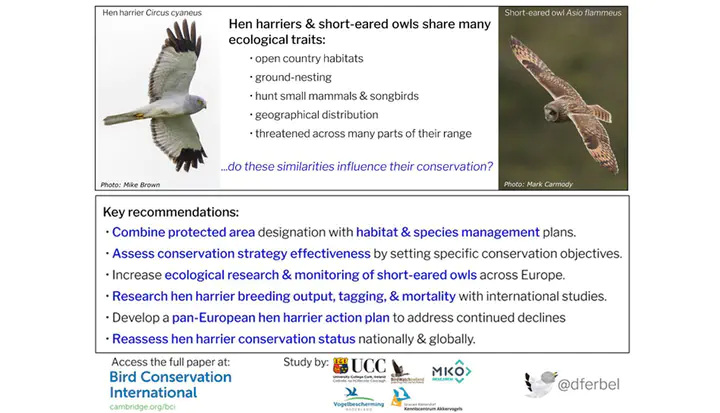Expert knowledge assessment of threats and conservation strategies for breeding Hen Harrier and Short-eared Owl across Europe

Abstract
Hen Harrier Circus cyaneus and Short-eared Owl Asio flammeus are open-country birds of prey with overlapping distributions. Although both species face similar conservation threats across their ranges, work to date has largely been undertaken at a national scale with few attempts to collate and assess factors relevant to their conservation at an international scale. Here we use an expert knowledge approach to evaluate the impact of conservation threats and the effectiveness of conservation strategies for each species across Europe. We report results of responses to a questionnaire from 23 Hen Harrier experts from nine countries and 12 Short-eared Owl experts from six countries. The majority of responses for both species reported declines in breeding numbers. The perceived impact of threats was broadly similar for both species: ecological factors (predation, extreme weather and prey availability), changes in land use (habitat loss and agricultural intensification) and indirect persecution (accidental nest destruction) were considered to be the greatest threats to breeding Hen Harrier and Short-eared Owl. Short-eared Owl experts also highlighted lack of knowledge and difficulties associated with monitoring as a major conservation challenge. Despite broad-scale similarities, geographical variation was also apparent in the perceived importance of conservation threats, with some threats (such as direct persecution, large-scale afforestation or habitat degradation) requiring country-specific actions. Implementation of different conservation strategies also varied between countries, with the designation of protected areas reported as the most widespread conservation strategy adopted, followed by species and habitat management. However, protected areas (including species-specific protected areas) were perceived to be less effective than active management of species and habitats. These findings highlight the overlap between the conservation requirements of these two species, and the need for collaborative international research and conservation approaches that prioritise pro-active conservation strategies subject to continued assessment and with specific conservation goals.